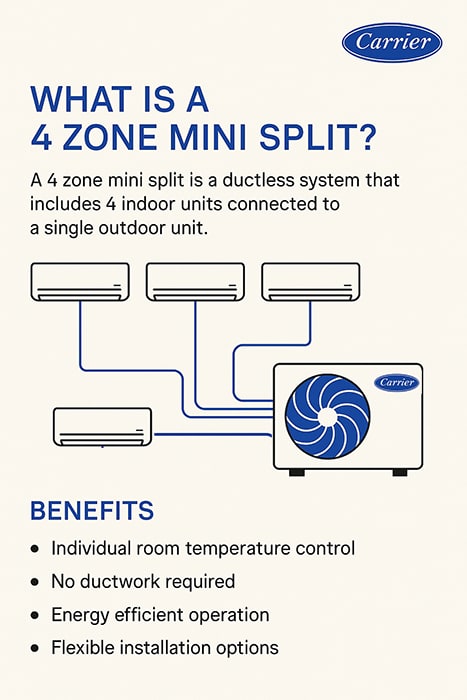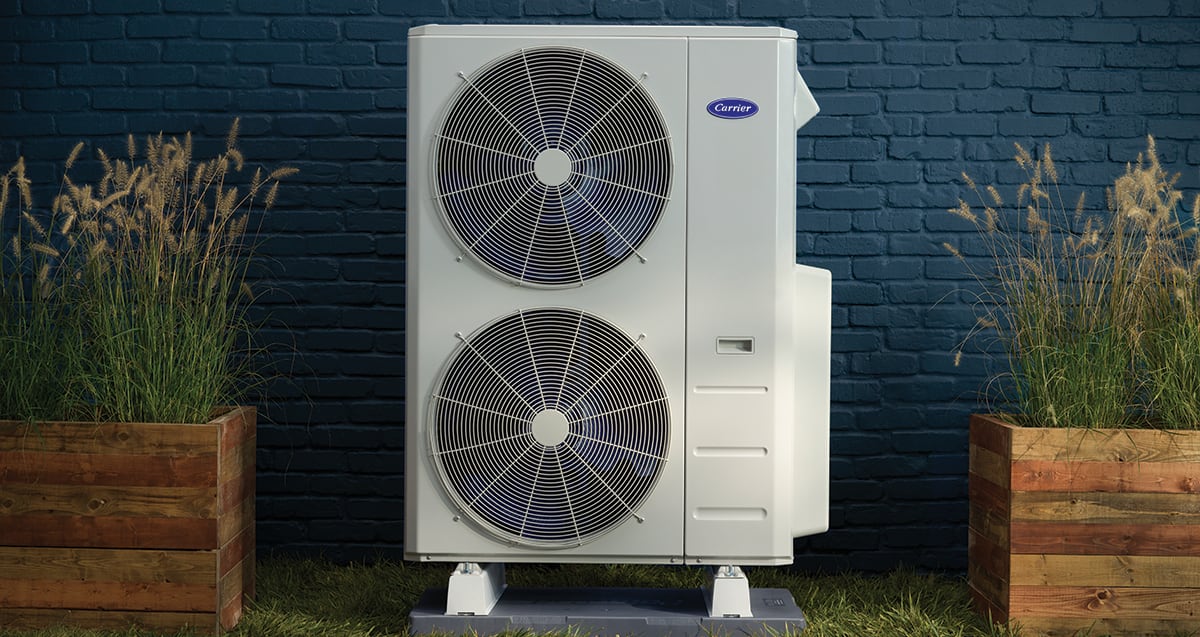About The Author: Travis Baugh is a Digital Brand Marketing Manager for Carrier, where he develops informative, straightforward content to help homeowners better understand heating, cooling, and indoor air quality. His writing is focused on empowering homeowners to make confident, well-informed choices about their home comfort systems.
4 Zone Mini Split
If you're looking for personalized comfort across multiple areas of your home, a 4 zone mini split system offers an energy-efficient way to heat and cool four separate zones with precision and control. These systems offer the flexibility to customize the climate in multiple rooms, ensuring each space maintains its ideal temperature. Let’s delve into what a 4 zone mini split system is, its keys components, and the reasons to choose Carrier for your mini split needs.
What Is a 4-Zone Mini Split?

A 4 zone mini split system is a ductless HVAC solution that allows you to independently heat or cool four different areas of your home. It consists of one outdoor compressor connected to four indoor air handlers, each serving its own zone. Each unit has its own thermostat, giving you customized temperature control in every space. This setup is ideal for larger homes, multi-level layouts, or families with different comfort preferences. Learn more about what is a mini split.
Four Zone Mini Split Benefits
Four zone mini splits come with many advantages. Here are some key advantages of choosing a four-zone mini split system for your home:
- Personalized Comfort: Personalized climate control is transformative for households with varied comfort needs. Each zone can be set to a different temperature, allowing every family member to enjoy their ideal climate.
- Energy Efficiency: Unlike traditional HVAC systems that condition an entire home at once, ductless mini splits only heat or cool the zones you’re using. This helps reduce energy waste and lower heating and cooling bills.
- No Ductwork Required: Ductless design makes installation easier, especially in older homes or additions without existing duct systems.
- Quiet Operation: Indoor units run quietly, making them ideal for helping provide a tranquil home setting.
- Inverter technology: Unlike fixed-speed HVAC systems, inverter technology allows the compressor to adjust speed based on demand, resulting in more efficient energy use, quieter operation, and consistent comfort.

Connect With A Carrier Dealer On 4 Zone Mini Split Systems
Connect with a Carrier dealer to determine if a 4 zone mini split system is the right fit for your home’s layout and comfort needs. Your local Carrier dealer will assess your space, recommend the ideal unit size, and design a zoned setup that maximizes efficiency. They’ll also ensure proper installation and provide ongoing support. With Carrier’s trusted mini splits and dealers, you can enjoy customized comfort in every room. Schedule an appointment today.
Single-zone system with up to 35.1 SEER2 and 30 HSPF2 for premium energy savings.
Single-zone system with up to 26 SEER2 and 13.9 HSPF2 for premium energy savings.
Single-zone system with up to 22.4 SEER2 for premium energy savings.
4 Zone Mini Split FAQs
A 4 zone mini split system is a ductless HVAC setup that allows you to heat or cool four separate areas or “zones” of your home independently. Each zone has its own indoor air handler connected to a single outdoor unit.
Sizing depends on each zone’s square footage and insulation, but a 4-zone system generally requires a 36,000 to 48,000 BTU outdoor unit. A professional HVAC contractor should perform a load calculation to ensure proper sizing.
The system uses a single outdoor compressor unit connected via refrigerant lines to four indoor units, each with its own thermostat. This setup enables each zone to operate at different temperatures based on individual preferences or room usage.
It provides personalized comfort, increased energy efficiency, and the ability to control temperatures in different rooms independently. It also avoids the need for ductwork, making it ideal for retrofits or additions.
Installation typically ranges from $8,000 to $10,500, depending on the brand, unit size, complexity of installation, and local labor rates.
Learn More About Ductless Mini Splits
- Read about ductless air conditioner cost
- Are mini splits efficient?
- How long do mini splits last?
- Discover ductless air conditioner for garage and other applications
- What is a ductless mini split?
- Mini split leaking water: diagnosis and repair




